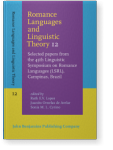Chapter 8
Locality constraints on θ-theory
Evidence from Spanish ditransitives
Sonia Kaminszczik | Consejo Nacional de Investigaciones Científicas y Técnicas – Universidad de Buenos Aires
Andrés Saab | Consejo Nacional de Investigaciones Científicas y Técnicas – Universidad de Buenos Aires
We focus on a pattern of Spanish se-reflexivization in ditransitive contexts that has not received due attention in the previous literature, namely, the impossibility of reflexivizing the direct object in presence of a dative clitic. In doing so, we will argue in favor of a particular long-distance approach to θ-assignment and against attract-based models. We will also defend the view of se as an edge marker (i.e., a v expletive) and argue against the hypothesis of se as residue of A-movement.
Article outline
- 1.Introduction
-
2.Theoretical assumptions
- 2.1Locality and theta-role assignment
- 2.2SE-reflexivity in Spanish
- 3.Deriving the main pattern
- 4.Further predictions
- 5.An alternative analysis
- 5.1The Movement Theory of Reflexivization
-
5.2Some problems for the MTR
- 6.Concluding remarks
-
Acknowledgements
-
Notes
-
References
